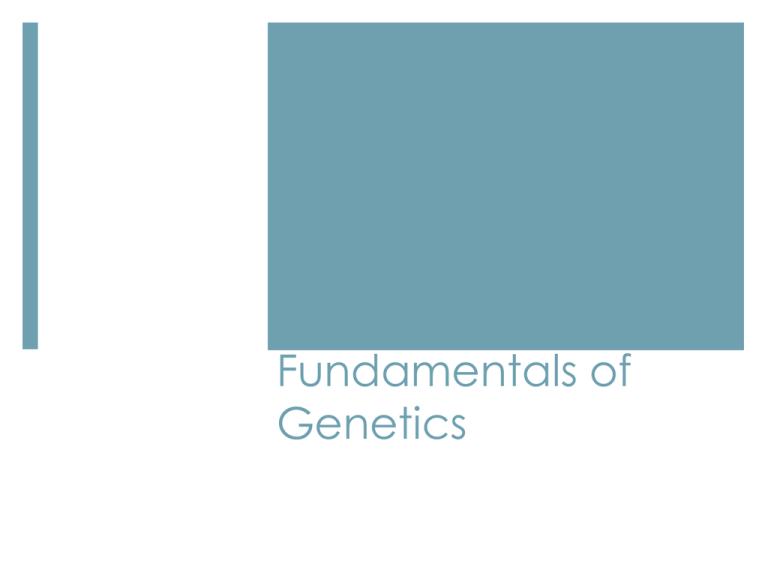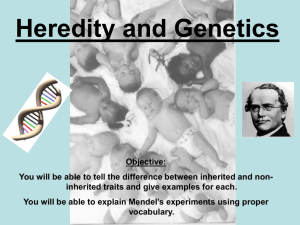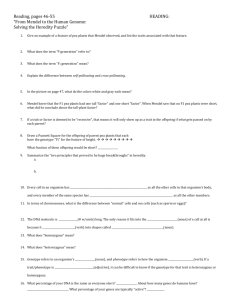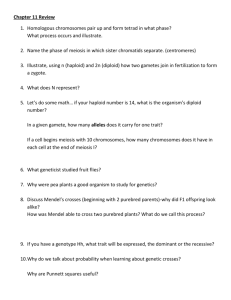Fundamentals of Genetics
advertisement

Fundamentals of Genetics What is genetics? Genetics: the science that studies how genes are transmitted from one generation to the next Gene: a segment of DNA that controls a hereditary trait Chromosomes = long chains of genes Heredity: the transmission of characteristics from parents to offspring Traits: the characteristics an organism has (ex: eye color, skin color, hair color, height) Gregor Mendel Austrian monk born in 1822 Known as the Father of Genetics Discovered three laws of genetics that would forever change biology Law of Dominance & Recessiveness Principle of Segregation Principle of Independent Assortment Conducted experiments in a quiet monastery garden & spent 14 years growing and experimenting with pea plants 1851- studied science & statistics at the University of Vienna Statistics proved valuable in his research on heredity His greatest contribution was to demonstrate that inherited characteristics are carried by genes Mendel’s Garden Peas Observed seven characteristics of pea plants 1. Plant height (tall vs. short) 2. Flower position along stem (axial vs. terminal) 3. Pod color (green vs. yellow) 4. Pod appearance (inflated vs. constricted) 5. Seed texture (round vs. wrinkled) 6. Seed color (yellow vs. green) 7. Flower color (purple vs. white) Garden peas a good choice because: They were readily available They were easy to grow They grew rapidly Collected seeds from his pea plants and carefully recorded each plant’s traits and seeds over a span of several years Mendel’s Experiments Pea flowers are normally self-pollinating Resulting embryos will have the same characteristics as the parent plant Mendel knew that these pea plants were “true breeding” (pure) Mendel cross-pollinated pairs of plants that were true breeding for contrasting traits of a single characteristic He called the true breeding parents the P generation P generation = Parental generation F1 generation = First generation of offspring F2 generation = Second generation of offspring Hybrids: the offspring of parents with different traits Following this process, Mendel performed hundreds of crosses & documented the results of each by counting and recording the observed traits of every cross In one of his experiments, Mendel crossed truebreeding tall plants with true-breeding dwarf plants Tall x dwarf all tall offspring The F1 hybrids were all tall All of the offspring had the appearance of only one of the parents The trait of the other parent seemed to have disappeared Mendel thought that the dwarf trait had been lost Next, Mendel allowed the hybrid tall offspring from the first generation to selfpollinate F1 tall x F1 tall offspring: ¾ tall and ¼ dwarf He found that ¾ of the offspring were tall and ¼ of the offspring were dwarf Offspring always at a 3:1 ratio Mendel’s Results & Conclusions The F1 tall offspring must have been carrying the dwarf trait but it had been hidden The dwarf trait had been passed down to the offspring and it reappeared in the F2 generation Mendel’s observations & records led him to hypothesize that biological inheritance is determined by “factors” that are passed from one generation to the next Today, we know these factors as genes or alleles He hypothesized that each trait was inherited by means of a separate allele Reasoned that a pair of alleles must control each trait Recessive & Dominant Traits Mendel realized that some traits are dominant over other traits He hypothesized that the trait appearing in the F1 generation was controlled by a dominant factor He thought that the trait that did not appear in the F1 generation but appeared in the F2 generation was controlled by a recessive factor A trait controlled by a recessive factor had no observable effect on an organism’s appearance Dominant vs. Recessive? 1. Pause note taking 2. Clasp your hands together 3. Which thumb did you put on top? Left? Right? Dominant: Placing left on top of right Recessive: Placing right on top of left Mendel’s observations from his experiments can be summarized in two principles: The Law of Segregation The Law of Independent Assortment The Law of Segregation Mendel concluded that the paired factors separate during the formation of reproductive cells Law of segregation states that a pair of factors is separated during the formation of gametes (egg and sperm cells) The Law of Independent Assortment Mendel also concluded that the factors for individual characteristics are not connected The law of independent assortment states that factors separate independently of one another during the formation of gametes Homozygous or Heterozygous An offspring will inherit two alleles for a trait, one allele from each parent The combination of alleles received may either be homozygous or heterozygous Homozygous = the two alleles are the same Ex: TT or tt Heterozygous = the two alleles are different Ex: Tt Genotypes & Phenotypes Genotype: the genetic makeup of an organism Phenotype: the physical characteristics of an organism (what the organism looks like) Ex: Genotype TT Tt tt Phenotype Tall Tall dwarf Exit Ticket Answer the following question: Many inherited disorders of humans appear in children of parents who do not have the disorder. How can you explain this?








